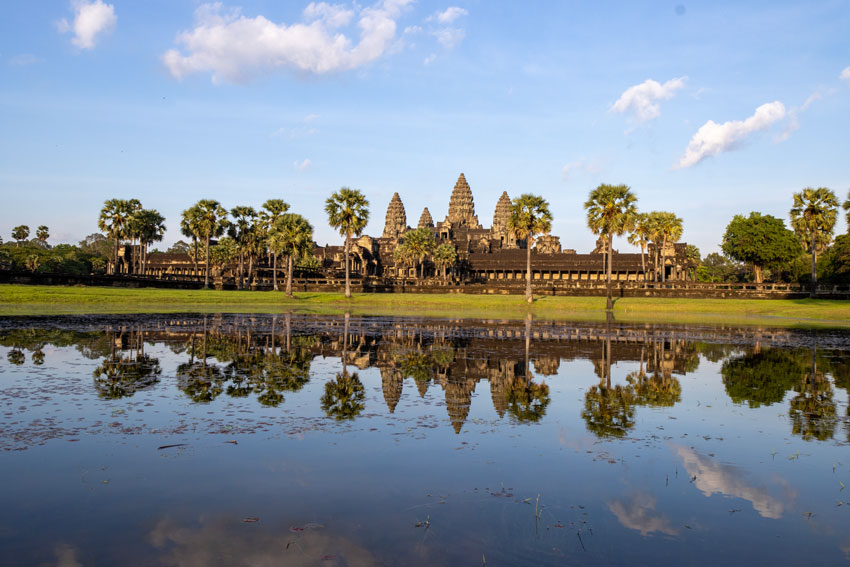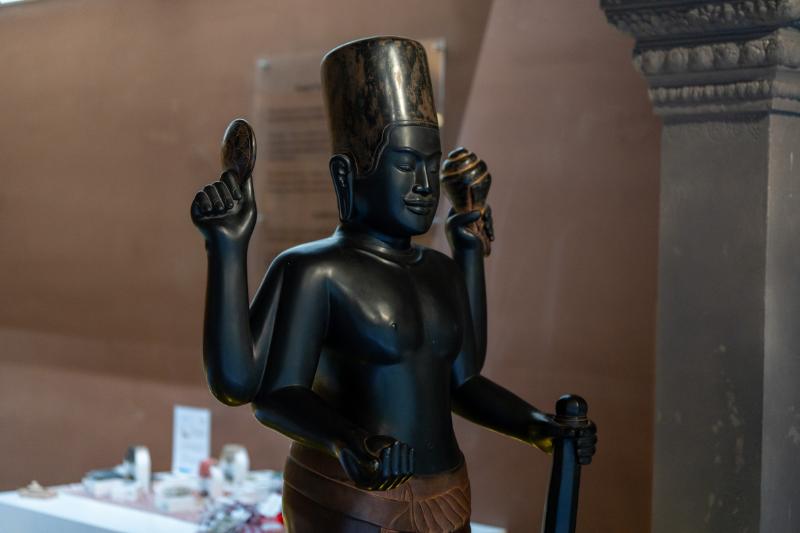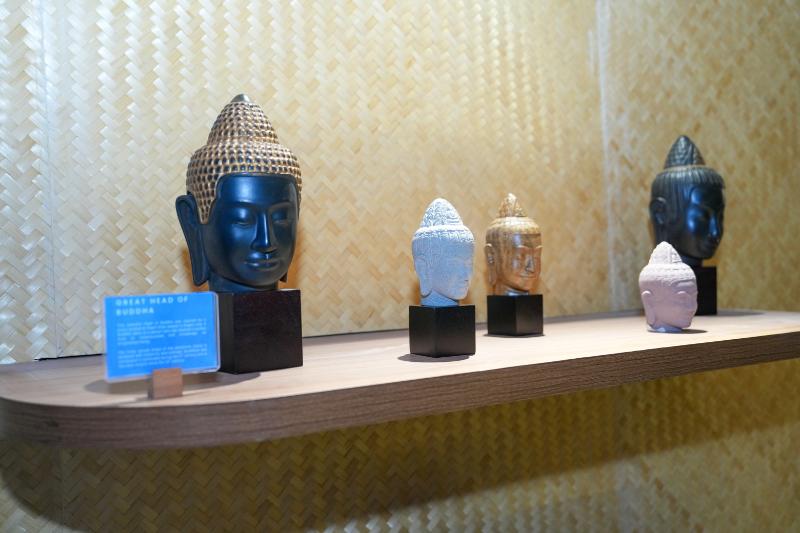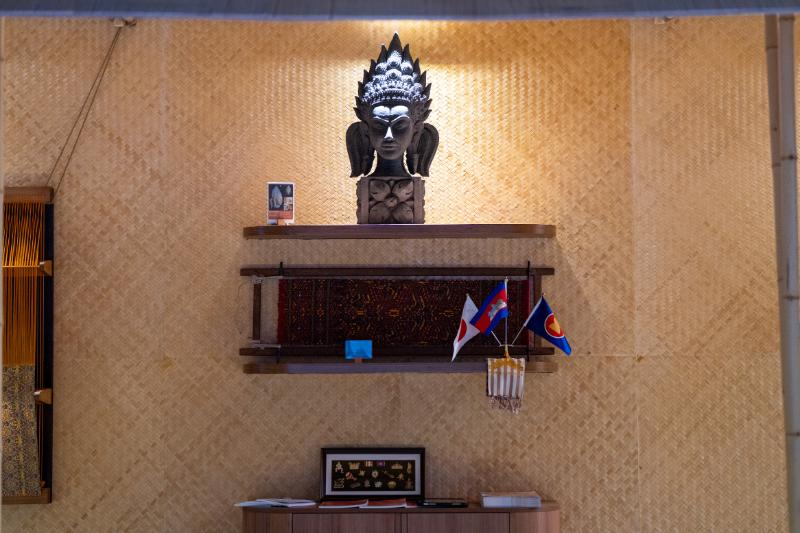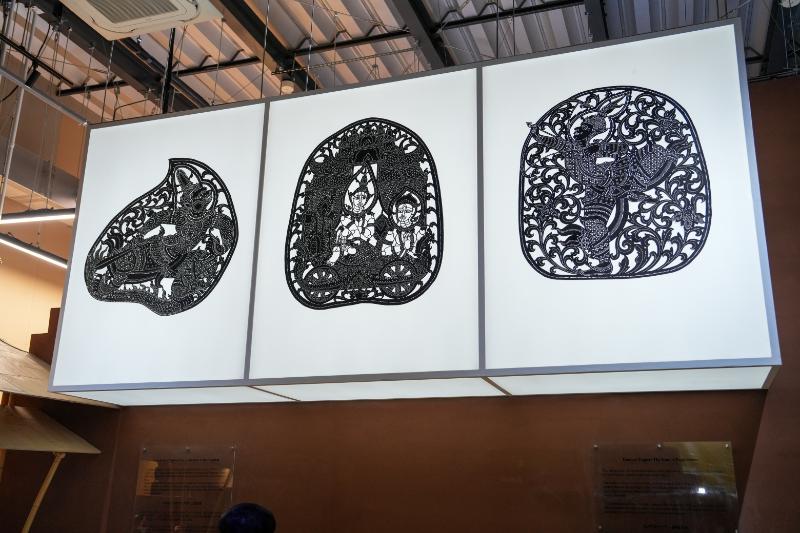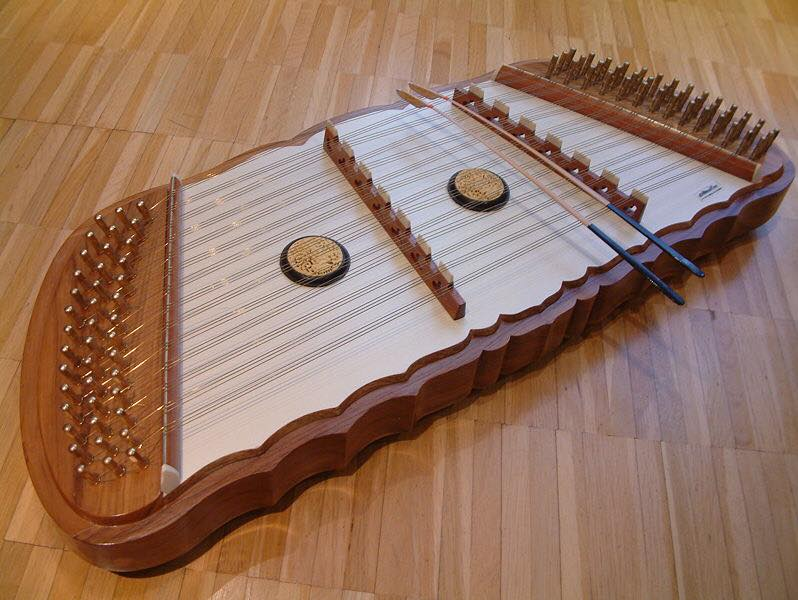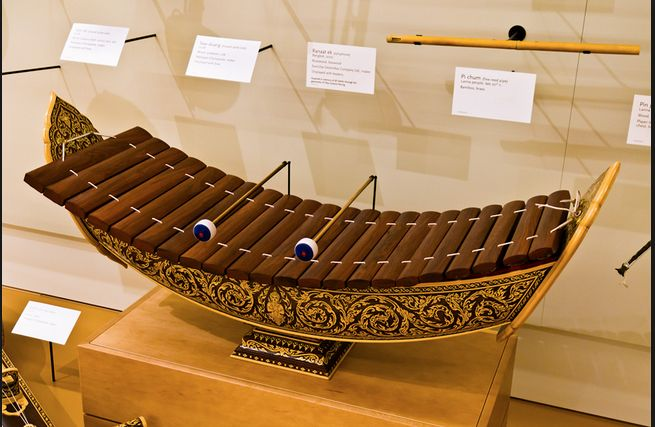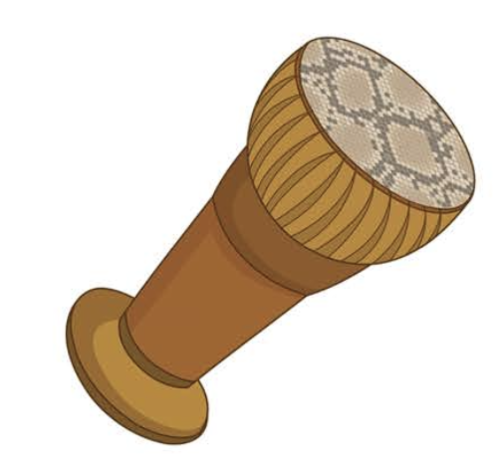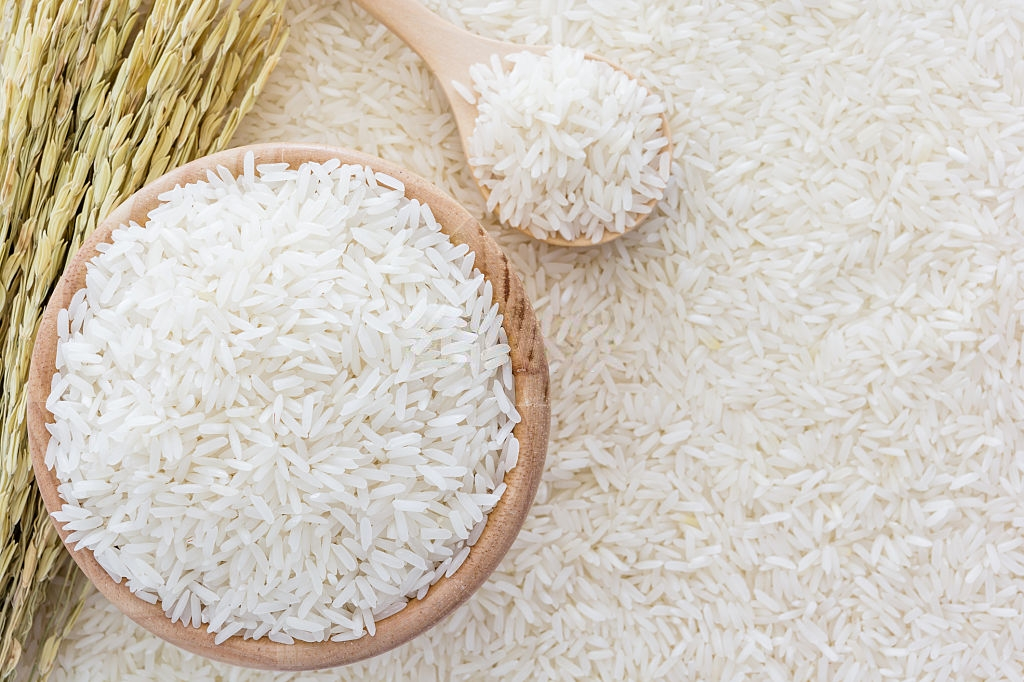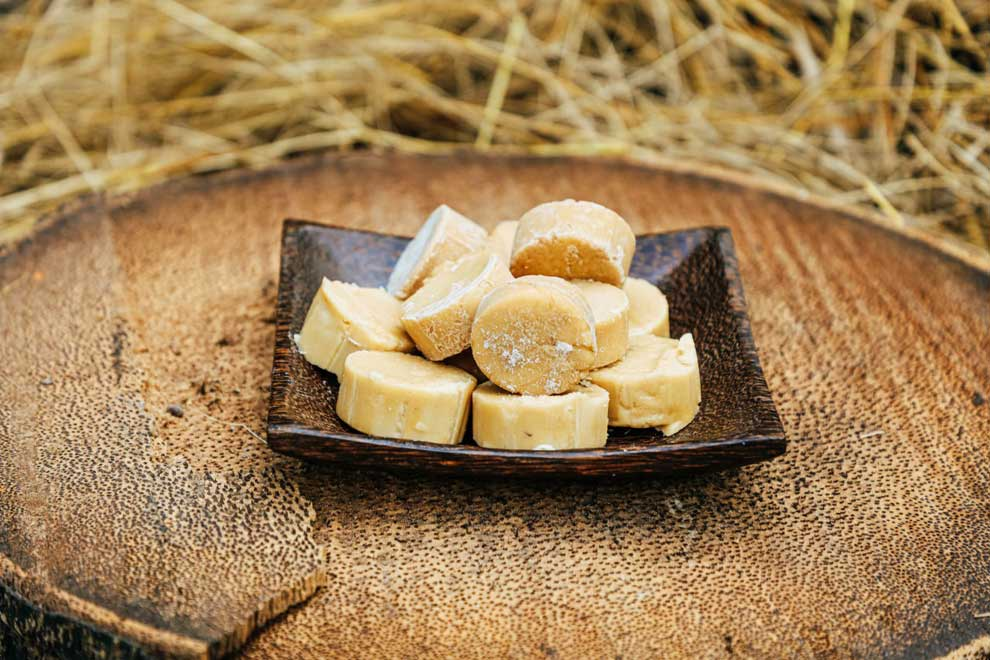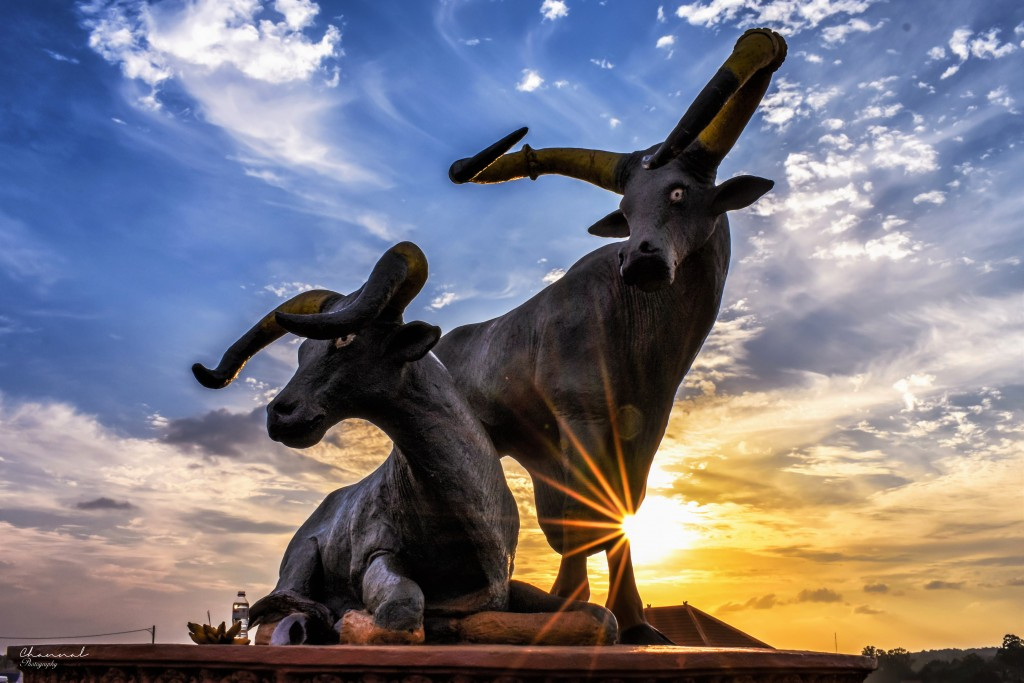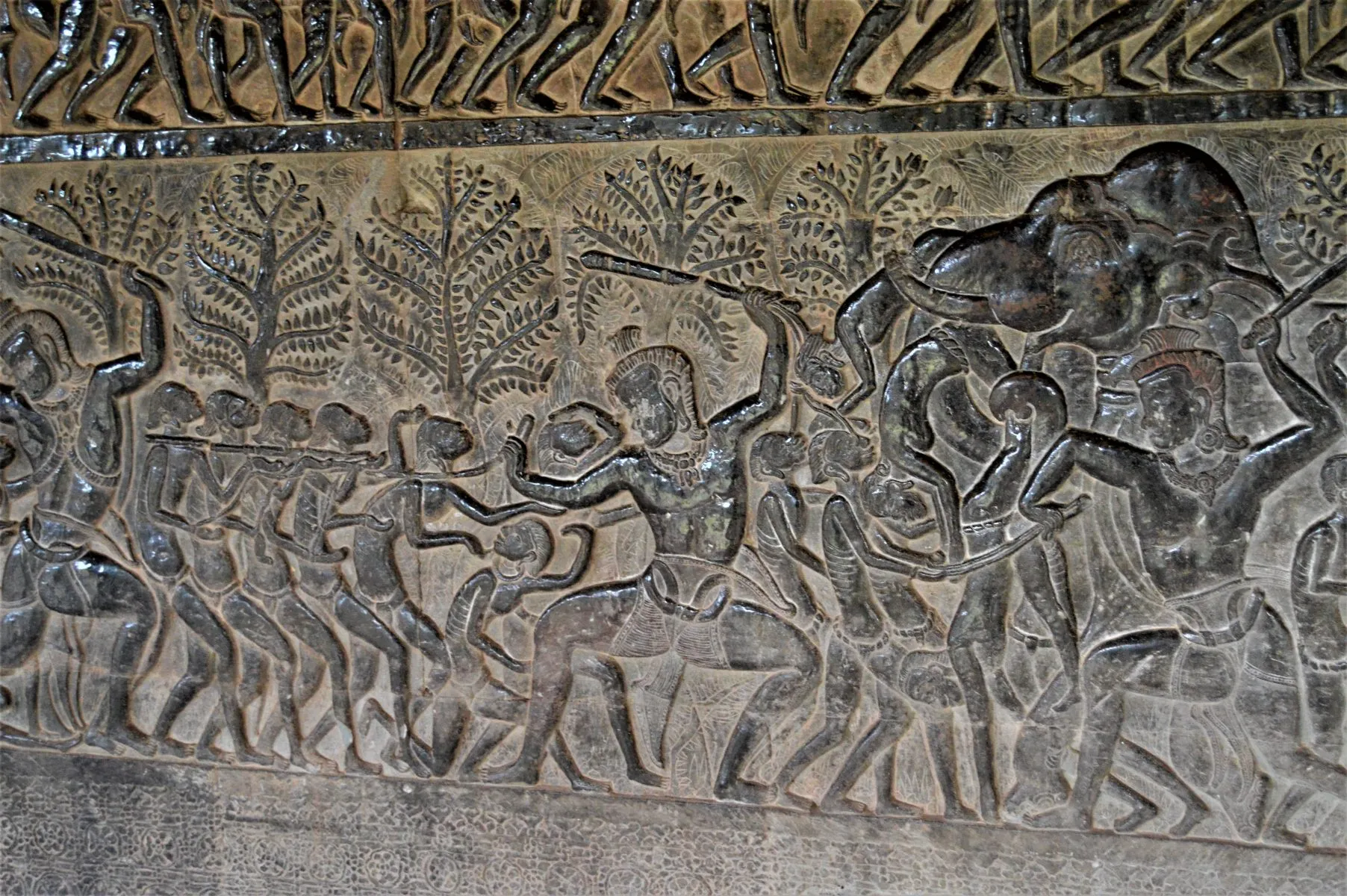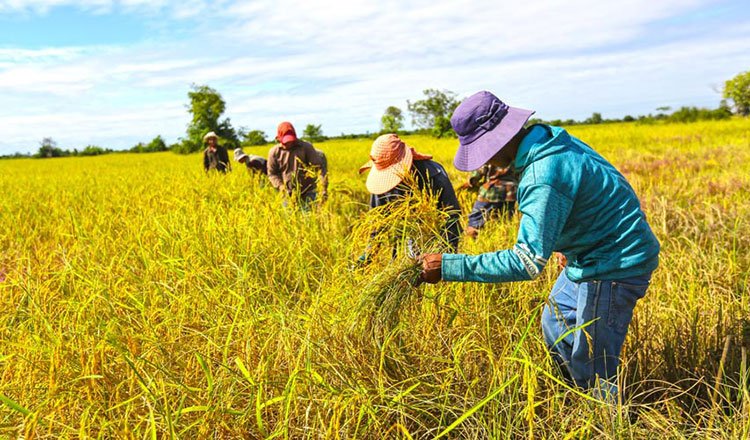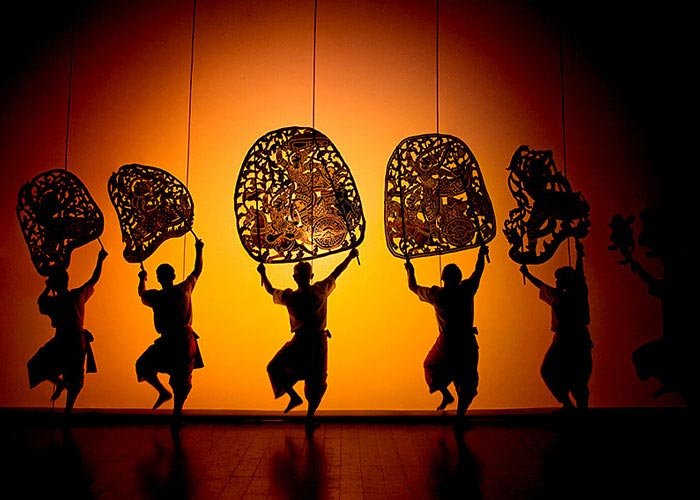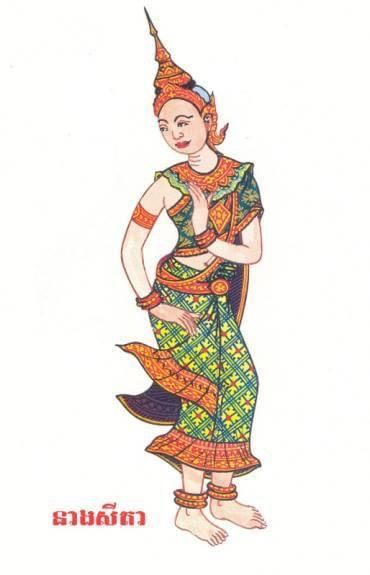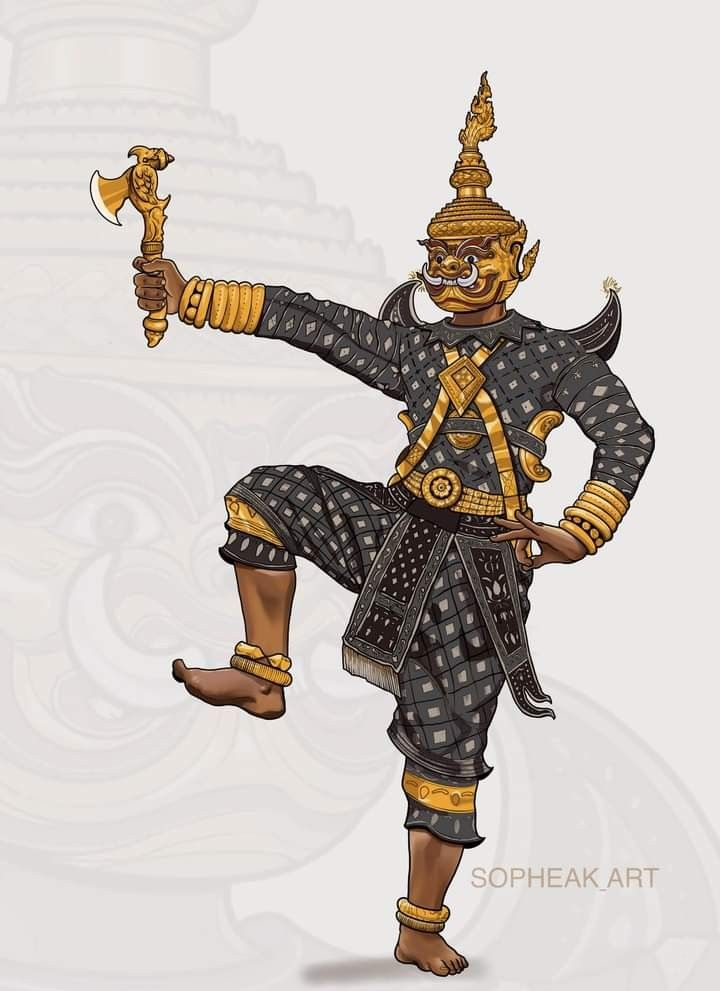Kouprey (Bos Sauveli)
Kouprey, the original Khmer name that means ‘wild ox’, with the scientific name Bos Sauveli, is a type of quadruped that lives in the forest, and it's about the size of a wild buffalo. They are found mostly in the fields and mountain forests of northern Cambodia and are also believed to live in southern Laos, western Vietnam, and eastern Thailand. They were first spotted in 1937.
During the 1960s, the King of the Kingdom of Cambodia designated and declared Kouprey as a symbol of Cambodia's natural heritage.
It is estimated that there are fewer than 250 wild oxen left in the world. The world considers the Kouprey to be a critically endangered species, listed in the IUCN Red List.
On 21 March 2005, the Kouprey was designated as the national animal of the Kingdom of Cambodia.
Cambodia Fishing
Cambodia’s fishery sector has evolved from traditional practices to modern sustainability efforts, deeply rooted in the Tonlé Sap Lake (1,483,339.00 ha), one of the world’s most productive freshwater ecosystems.Cambodia’s fishery sector has evolved from traditional practices to modern sustainability efforts, deeply rooted in the Tonlé Sap Lake (1,483,339.00 ha), one of the world’s most productive freshwater ecosystems. Historically, communities relied on seasonal flooding and traditional methods like bamboo traps. During the French colonial period, modernization began, but traditional practices persisted. Post-independence, political instability and the Khmer Rouge regime disrupted the sector, but recovery began in the 1990s with community-based fisheries management (CBFM) and government policies.
Today, Cambodia’s fishery faces challenges like climate change, overfishing, and habitat loss, but innovations in sustainable aquaculture, conservation, and technology are driving progress. Fisheries contribute significantly to the economy, supporting over 2 million livelihoods and providing 52 kg of fish per person annually, making fish a primary protein source. The future focuses on balancing growth with sustainability, ensuring the sector’s resilience.
Angkor Wat Temple
Angkor Wat - Heritage of Humanity and World Wonder
The Angkor Wat Temple is the most famous of all Angkorian temples. Back in the 12th century, it was built by King Suryavarman II, which took an estimated 30 years to build and covered over 162.6 hectares (400 acres). It was initially dedicated to the Hindu god, Vishnu but was later dedicated to Buddhism, and this temple is the only one of the Angkorian temples to remain in religious use throughout the centuries. Its iconic five towers symbolize Mount Meru, the center of the universe in Hindu and Buddhist cosmology.
The temple is renowned for its intricate bas-reliefs, stretching over 1,000 square meters, depicting scenes from Hindu epics like the Churning of the Ocean of Milk. Recognized as a UNESCO World Heritage Site in 1992, Angkor Wat attracts over 2.6 million visitors annually, making it Cambodia’s most treasured landmark.
Koh Ker Temple
Koh Ker temple, located in Preah Vihear Province, is a 10th-century temple built during the reign of King Jayavarman IV (AD 928–942). This small but elegant temple is part of the Koh Ker archaeological site, which served as the capital of the Khmer Empire for a brief period. The temple features a single laterite tower and is surrounded by lush forest, offering a serene and off-the-beaten-path experience for visitors. Koh Ker temple is 35 meters high, and its design resembles a seven-stepped stupa. The temple faces west toward the Angkor City. It was built to worship Treypuvanesvara, the god of happiness.
Koh Ker Temple, including Prasat Kok Ker, is recognized as a UNESCO World Heritage Site (inscribed in 2023) and is renowned for its unique architectural style and historical significance. The site is home to over 180 monuments, showcasing the Khmer Empire’s artistic and engineering prowess.
Preah Vishnu (Wooden Statue)
Standing Vishnu
Lord Vishnu is a Hindu deity who preserves and sustains the universe. He represents the aspect of the Supreme Reality and is occasionally called upon to save the world from some great calamity.
His raised left hand holds a mace, and his raised right hand a war discus. His lower left hand holds a conch, and his lower right, a round object symbolizing the fruit of knowledge. The two front arms indicate Vishnu's activities in the physical world, and the two back arms signify his activity in the spiritual world. The four arms are the signs of Vishnu's omnipresence and omnipotence.
It took 500 hours for our artisans to carve this piece in wood, 144 hours for plastering and 40 hours for the polychrome process and gilding.
Dimensions: H170cm*L45cm*D64cm
Weight: 67 Kg
Made in Cambodia by Artisans Angkor
Head of Lokesvara
HEAD OF LOKESVARA
This majestic head, handmade in sandstone, depicts Lokesvara, one of the great Bodhisattva of Mahayana Buddhism. The piece was inspired by the specimen named "Radiant Lokesvara" located at Preah Khan Kampong Svay.
Lokesvara is known as the Lord of Compassion. During the reign of King Jayavarman VII, his cult enjoyed an unprecedented favor.
Ref.: 1712
Dimensions: Wide 25cm, High 64cm, Long 30cm
Made in Artisans Angkor workshops
Head of Jayavarman VII
HEAD OF JAYAVARMAN VII
This sandstone masterpiece, portraying the head of King Jayavarman VII, is inspired by a piece from Angkor Thom, Bayon style, which is now located at the National Museum of Phnom Penh.
Jayavarman VII is considered the greatest king of Cambodia for unifying the country. His legacy lives on today, as he was responsible for the construction of several Angkor temples, including the stunning Bayon temple with its enigmatic face towers.
Ref.: 1711
Dimensions: Wide 25cm, High 52cm, Long 33cm
Made in Artisans Angkor workshops
Great Head of Buddha
This peaceful Head of Buddha was inspired by a piece located at Preah Khan temple in Angkor site. A Buddha refers to a person who has reached a perfect level of consciousness and knowledge, an enlightened being.
The finely carved shape of the sandstone statue is rendered with simplicity and softness. Buddhism was introduced in Cambodia during the 5th century and is the state religion since the 13th century.
Ref.: 1713
Dimensions: Wide 60cm, High 24cm, Long 27cm
Made in Artisans Angkor workshops
Head of Indradevi
Head of Indradevi Recycled handmade from Sawdust, Total Weight: 5Kg
was a queen of the Khmer Empire through her marriage to King Jayavarman VII (r. 1181–1219).
Reportedly, she influenced affairs of state through her spouse, particularly in favor of Buddhism. She was also active as a poet and as a professor.
Traditional Sbek Thom carved a story of Hanuman, Preah Ream and Seta
Sbek Thom: The Epic Tale of Hanuman, Preah Ream, and Seta
Sbek Thom, or Khmer shadow theater, is a centuries-old art form that brings to life the epic Reamker, Cambodia’s adaptation of the Indian Ramayana. Using intricately carved leather puppets, performers narrate the adventures of Preah Ream (Rama), Seta (Sita), and the loyal monkey warrior Hanuman.
The puppets, often over 2 meters tall, are crafted from a single piece of leather and depict scenes of love, bravery, and divine intervention. Performances are accompanied by traditional music and chanting, creating a mesmerizing experience. Recognized as a UNESCO Intangible Cultural Heritage of Humanity in 2008, Sbek Thom is a treasured part of Cambodia’s cultural identity.
Carved Sculpture
Cambodia’s Traditional Carved Sculpture: A Legacy of ArtistryCambodian traditional carved sculpture is a testament to the country’s rich artistic heritage, dating back to the Khmer Empire (9th–15th centuries). Skilled artisans use materials like sandstone, wood, and bronze to create intricate statues of Hindu and Buddhist deities, such as Vishnu, Shiva, and the Buddha, as well as mythological figures like Apsaras (celestial dancers).
The sculptures are renowned for their graceful poses, detailed ornamentation, and spiritual symbolism. Techniques have been passed down through generations, preserving the artistry seen in iconic sites like Angkor Wat and the National Museum of Cambodia.
Recognized globally for their beauty and craftsmanship, these sculptures reflect Cambodia’s deep connection to religion, history, and culture.
KEOM (Butterfly shape xylophone)
Made from wood with two sticksThe Kong Ey Mong (KEOM) is a traditional Cambodian xylophone, uniquely shaped like a butterfly. This elegant instrument is made from bamboo or wood, with precisely tuned keys that produce a melodic and resonant sound. It is often used in Khmer classical music ensembles, accompanying traditional dances, ceremonies, and storytelling performances.
The KEOM’s design reflects Cambodia’s deep connection to nature and artistry. Its soothing tones are integral to the Pinpeat orchestra, which performs at royal events and religious rituals. The instrument symbolizes the harmony between music, culture, and spirituality in Cambodian tradition.
KUONG Thom (circle shape xylophone) is made from wood and copper
Kuong Thom: The Circular Xylophone of Cambodia
The Kuong Thom is a traditional Cambodian xylophone, uniquely shaped in a circle to symbolize unity and harmony. Crafted from bamboo or wood, its carefully tuned keys produce rich, melodic tones that are central to Khmer classical music.
The Kuong Thom is often played in the Pinpeat orchestra, accompanying traditional dances, royal ceremonies, and religious rituals. Its circular design reflects the Cambodian belief in the cyclical nature of life and the interconnectedness of all things.
This instrument is a testament to Cambodia’s artistic ingenuity and cultural depth.
Rama
Prince Rama, the son of King Dasaratha and husband of Princess Sita, was abducted by Ravana and taken to Lanka. The entire story of Reamker (Ramayana) revolves around Rama's journey to find Sita, always with the help of monkey warriors and other allies. Prince Rama has a human form, is characterized by green skin, and wears a "Ney Rong" crown. Furthermore, Prince Rama is an avatar of Vishnu. This image depicts Prince Rama in the act of shooting an arrow.
RO NEAT (xylophone) is made from wood with two sticks.
The Ro Neat is a traditional Cambodian xylophone, crafted from bamboo or wood, known for its warm and resonant tones. It is a key instrument in the Pinpeat orchestra, which accompanies classical dance, royal ceremonies, and religious rituals.
The Ro Neat’s design features carefully tuned keys, often arranged in a rectangular frame, and is played with mallets wrapped in soft material to produce its distinctive sound. This instrument reflects Cambodia’s rich musical heritage and the skill of its artisans.
DRUM
Cambodia’s Traditional Drum: The Heartbeat of Khmer Culture
The traditional Cambodian drum, known as Skor or Skor Thom, is a vital instrument in Khmer music and ceremonies. Made from wood and animal hide, these drums produce deep, resonant tones that set the rhythm for traditional performances.
The Skor is often used in the Pinpeat orchestra, accompanying classical dance, religious rituals, and festive celebrations. Its powerful beats symbolize the heartbeat of Cambodia’s cultural identity, connecting the past to the present.
Crafted by skilled artisans, each drum is a work of art, reflecting the harmony between craftsmanship and tradition.
Malis Rice
Cambodia’s Malis rice is a symbol of the Kingdom’s agricultural excellence, prized for its superior quality and distinct fragrance.
✔️ Award-winning Malis rice is cultivated in the fertile plains of Cambodia, enriched by the Mekong River and the Tonlé Sap Lake. These waterways provide the ideal conditions for growing some of the best rice in the world.
✔️ Known for its rich aroma and delicate texture, Malis rice is a staple in Khmer cuisine, deeply rooted in Cambodia’s culture and daily life. The rice is not only celebrated locally but is also gaining recognition on the global stage, being exported to international markets.
✔️ The commitment to sustainable farming practices ensures that Malis rice is produced with minimal environmental impact while maintaining the highest standards of quality. Malis rice represents Cambodia’s dedication to sustainability, innovation, and preserving agricultural heritage.
Mango
Cambodian Mango: The Golden Fruit of the Kingdom
Cambodia’s mangoes are celebrated for their sweet flavor, vibrant color, and juicy texture. Grown in the fertile plains of the Mekong River Basin, Cambodian mangoes are a staple of the country’s agriculture and cuisine. Popular varieties include the Keo Romiet and Keo Ktis, which are enjoyed fresh, dried, or in traditional dishes like green mango salad or dry mango.
Mango farming is a vital part of Cambodia’s economy, with the country being one of the top mango exporters in Southeast Asia; as in 2024 Cambodia exported mangoes worth about $145.79 million. The fruit is also deeply rooted in Cambodian culture, symbolizing abundance and prosperity.
Cashew Nuts
Cambodian Cashew Nuts: A Treasure of the Kingdom
Cambodia’s cashew nuts are celebrated for their rich flavor, creamy texture, and premium quality. Grown primarily in the northeastern provinces like Kampong Thom and Ratanakiri, Cambodian cashews are a cornerstone of the country’s agriculture.
Multiple locally developed cashew nuts varieties are M23, H09, M1, M10, IM4 and SAN1. Cambodia’s Cashew nuts are popular when roasted and salted, adding a delightful crunch and nutty flavor to dishes like stir-fries, curries, salads and desserts.
The cashew industry supports over 15,000 farming families, contributing significantly to rural livelihoods. Notably, 90% of Cambodia’s cashew harvest is exported to international markets, including Vietnam, and also to some other countries like China, Korea, Europe, Thailand, Japan, India, and the United Kingdom, to name a few, of which the total export reached $503.79 million in 2024. Many farms use eco-friendly practices, ensuring sustainable production.
In Cambodian culture, cashews are enjoyed as a snack, in desserts, or as a key ingredient in traditional dishes. They symbolize prosperity and the bounty of the land.
Durian
Cambodian Durian: The King of Fruits
Durian, often called the "king of fruits", is a prized fruit in Cambodia, known for its distinctive strong aroma and rich, creamy texture. Key durian-producing provinces include Battambang, Kampot, Pursat, Kampong Cham, Tboung Khmum, Koh Kong, and Ratanakiri. The climate provides ideal conditions for this tropical fruit. The durian harvesting season in Cambodia typically spans from April to July, making it a popular fruit during the country's summer months.
Cambodian durians are renowned for their sweet, less pungent flavor compared to varieties from other countries, making them highly sought after in international markets. The industry supports numerous smallholder farmers and plays a vital role in rural economic development.
Kampot pepper
Cambodia Kampot Pepper: A World-Renowned SpiceKampot Pepper, grown in the Kampot and Kep provinces of southern Cambodia, is globally renowned for its distinctive aroma, flavor, and exceptional quality. The pepper is cultivated in the mountainous regions, where the rich, volcanic soil, combined with the tropical climate and traditional farming methods, creates ideal growing conditions. Kampot Pepper is produced in three varieties: black, white, and red, each offering a unique flavor profile that elevates both local and international cuisines.
In 2016, Kampot Pepper received the prestigious Protected Geographical Indication (PGI) status from the European Union, recognizing its unique taste and connection to the Kampot-Kep region. On April 02, 2010, it was also awarded the Geographical Indication (GI) certification in Cambodia by the Ministry of Commerce, ensuring that only pepper grown in these areas can be marketed under the Kampot Pepper name. This certification has helped boost the reputation of Kampot Pepper, which is now exported to over 50 countries. In 2024, Cambodia exported about $35.27 million of pepper to the world, mostly to Europe.
Kampot Pepper has become a symbol of Cambodia's commitment to quality agriculture and sustainable farming practices.
Kampong Speu Palm Sugar
Cambodia Kampong Speu Palm Sugar: A Sweet Taste of TraditionKampong Speu Palm Sugar, produced in the Kampong Speu province of Cambodia, is a traditional sweetener known for its rich flavor and natural, caramel-like taste. It is made by extracting the sap from the flowers of sugar palm trees, which is then boiled down to create the sugar. The production process, which has been passed down through generations, is completely organic, with no artificial additives, making it a popular choice for both local cooking and international markets.
In 2019, Kampong Speu Palm Sugar was awarded the prestigious Protected Geographical Indication (PGI) status from the European Union, recognizing its distinctive quality and connection to the Kampong Speu region. On April 2, 2010, it also received the Geographical Indication (GI) certificate in Cambodia from the Ministry of Commerce, ensuring that only palm sugar produced in Kampong Speu can be marketed under the Kampong Speu Palm Sugar name.
Kampong Speu Palm Sugar is a true reflection of Cambodia’s rich cultural heritage and commitment to sustainable agriculture.
Koh Trung Pomelo
Cambodia Koh Trung Pomelo: A Jewel of Cambodian AgricultureKoh Trung Pomelo, grown in the Koh Trung district of Kratie province, is a prized variety of pomelo known for its delicate sweetness and refreshing flavor. This pomelo stands out due to its large size, greenish-yellow rind, and juicy flesh, which can range from white to pink. The fruit’s unique quality is attributed to the fertile soil and tropical climate of the Mekong River basin, where the pomelos are cultivated.
In 2018, Koh Trung Pomelo received the Geographical Indication (GI) certification from the Ministry of Commerce, ensuring that only pomelos grown on Koh Trung Island can be marketed as Koh Trung Pomelo. In 2019, Koh Trung Pomelo was granted Protected Geographical Indication (PGI) status by the European Union, recognizing its exceptional characteristics tied to the region’s specific conditions. The cultivation of this pomelo has significantly contributed to the region's economy, providing sustainable livelihoods for local farmers.
Mondulkiri Wild Honey
Cambodia Mondulkiri Wild Honey: Pure and Natural SweetnessMondulkiri Wild Honey, harvested from the Apis dorsata bee, a giant honeybee, in the forests of Mondulkiri province in eastern Cambodia, is renowned for its unique taste and natural purity. Produced by wild bees foraging on diverse flowers from the untouched forests, the honey boasts a rich, floral aroma and smooth texture, prized for its distinctive flavor and health benefits. The region’s diverse ecosystem, with its mix of tropical flowers and herbs, contributes to the honey’s exceptional qualities, making it highly sought after both locally and internationally.
On January 29, 2021, it received the Geographical Indication (GI) certificate in Cambodia from the Ministry of Commerce, ensuring that only honey produced in Mondulkiri can be marketed as Mondulkiri Wild Honey. This certification further assures its premium quality. The Mondulkiri wild honey industry comprises approximately 300 honey harvesters, with 73 registered members in the Mondulkiri Wild Bee Conservation Association (MWBCA). It is primarily exported to markets in Europe.
Kampot-Kep Fish Sauce
Cambodia Kampot-Kep Fish Sauce: A Flavorful Tradition of CambodiaKampot-Kep Fish Sauce, produced in the Kampot and Kep provinces of southern Cambodia, is renowned for its high-quality craftsmanship and distinctive, savory flavor. This fish sauce is made using a traditional fermentation process that involves fresh, locally sourced anchovies and sea salt. The fish sauce has a rich umami taste, making it a key ingredient in Cambodian cuisine, widely used in dipping sauces, soups, and marinades.
In 2023, it received the Geographical Indication (GI) certificate in Cambodia from the Ministry of Commerce, ensuring that only fish sauce produced in Kampot and Kep can be marketed as Kampot-Kep Fish Sauce.
Kampot-Kep Fish Sauce is more than just an ingredient—it's a symbol of sustainable fishing practices and local heritage.
Kampot-Kep Salt
Cambodia Kampot-Kep Salt: A Premium Salt from Cambodia’s Coastal Region
Kampot-Kep Salt, harvested in the Kampot and Kep provinces of southern Cambodia, is famous for its high mineral content and distinctive, clean taste. The salt is produced through traditional methods, where seawater is evaporated under the hot sun in salt ponds along the coast. The unique combination of tropical climate, clean seawater, and hand-harvesting techniques contributes to the premium quality of Kampot-Kep Salt, which has made it a sought-after product both locally and internationally.
In 2023, it received the Geographical Indication (GI) certificate in Cambodia from the Ministry of Commerce, ensuring that only salt produced in these regions can be marketed as Kampot-Kep Salt. The salt industry provides income for local farmers, with over 200 families involved in production.
Kampot-Kep Salt has become a symbol of Cambodia’s commitment to sustainable agriculture and authentic, high-quality products.
Takeo Giant River Prawn
Cambodia Takeo Giant River Prawn (Lobster): A Prized Aquatic DelicacyTakeo Giant River Prawn, native to the Takeo province in southern Cambodia, is a celebrated freshwater prawn known for its large size and delicate, sweet flavor. These prawns thrive in the Mekong River and other water streams, benefiting from the clean, nutrient-rich waters of the region. The prawns are cultivated through sustainable aquaculture practices, with local farmers utilizing traditional methods that ensure the prawns’ premium quality and natural taste.
There are two types: lobsters caught from rivers and natural lakes, harvested between September and January; and naturally farmed lobsters, harvested between June and August.
In 2023, it also received the Geographical Indication (GI) certificate from the Cambodian Ministry of Commerce, ensuring that only prawns harvesting in the Takeo region can be marketed under this name.
Takeo Giant River Prawn is not only a valuable culinary ingredient but also a symbol of Cambodia’s commitment to sustainable fisheries.
Kouprey (Bos Sauveli) & Fishery
The Kouprey, derived from the original Khmer name meaning "Wild Ox," is a rare and distinctive species scientifically known as Bos sauveli. Comparable in size to a wild buffalo, this quadruped inhabits dense forests and open fields, primarily in northern Cambodia.
In the 1960s, the King of Cambodia officially proclaimed the Kouprey as a symbol of the nation’s natural heritage. On March 21, 2005, it was officially designated as the national animal of the Kingdom of Cambodia.
-------
Cambodia is endowed with abundant water resources, including the Great Lake Tonle Sap, the Mekong River, the Tonle Sap River, and the Bassac River.
The fisheries sector is vital to Cambodia’s economy and food security which supports millions of livelihoods. In 2021, fisheries contributed 7-8% to the national GDP, with per capita fish consumption reaching 52.4 kg.
Cambodia Handicraft
Wood carving was a pillar of the Khmer Empire’s artistic heritage, serving as a blueprint for monumental works and an essential training ground for stone carvers. While wooden sculptures are widely available in markets, only a handful of stalls offer authentic, locally crafted pieces. Visitors to the Cambodia Pavilion can acquire exquisite, handcrafted wood carvings by the region’s most skilled artisans, helping to preserve this time-honored tradition.
Khmer ceramics, with a history spanning over 7,000 years, are highly prized for their distinctive designs and exceptional craftsmanship.
Bas Relief of Angkor Wat
Bas-Reliefs of Angkor Wat: A Masterpiece of Khmer Art
The bas-reliefs of Angkor Wat, carved in the 12th century, are among the most stunning achievements of Khmer art. Covering over 1,000 square meters of the temple’s walls, these intricate carvings depict scenes from Hindu epics like the Ramayana and Mahabharata, as well as historical events and celestial imagery.
The most famous relief, the Churning of the Ocean of Milk, illustrates the creation of the universe, showcasing the Khmer Empire’s deep spiritual and artistic vision. Each panel is a testament to the skill and dedication of Khmer artisans, who transformed sandstone into timeless stories.
Recognized as a UNESCO World Heritage Site, Angkor Wat’s bas-reliefs continue to inspire awe and admiration, offering a window into Cambodia’s glorious past.
Cambodia Traditional Ethic House
The Cambodian Ethnic Bamboo House, deeply intertwined with the nation's history, embodies the traditional architecture and cultural heritage of rural Cambodia. Defined by its elevated wooden platforms and thatched roof, this dwelling was traditionally built using locally sourced materials such as bamboo, timber, and straw. Its raised design not only facilitated natural ventilation but also provided protection against seasonal floods and minimized pest intrusion. The structure typically featured a simple yet functional layout, with the ground level reserved for livestock and tool storage, while the upper floor served as the primary living space.
Cambodia Rice
Cambodian Rice: The Golden Grain of Life
Rice is the heart of Cambodia’s culture, cuisine, and economy. Known for its fragrant and high-quality varieties, such as Phka Malis (Jasmine Rice), Cambodian rice is cultivated in the fertile plains of the Mekong River Basin.
Cambodia’s rice farming traditions date back over 2,000 years, with techniques passed down through generations. The country’s rice is celebrated for its organic farming practices and has won the World’s Best Rice Award multiple times, including in 2012, 2013, 2014, 2018, 2022 and 2024.
Rice is not just a staple food but also a symbol of prosperity and life in Cambodian culture. It is central to festivals, rituals, and daily meals, reflecting the deep connection between the people and their land.
Preah Shiva (Wooden Statue)
Standing Shiva
Lord Shiva is a major Hindu deity who continuously dissolves to recreate in the cyclic process of creation, preservation, dissolution and recreation of the universe. He represents the aspect of the Supreme Being and is the destroyer god or transformer among the Hindu Trinity of the primary aspects of the divine.
It took 500 hours for our artisans to carve this piece in wood, 208 hours for plastering and 40 hours for the polychrome process and gilding.
Dimensions: H187cm*L40cm*D64cm
Weight: 79 Kgs
Made in Cambodia by Artisans Angkor
Koh Ker Archaeological Site
Koh Ker archaeological site was inscribed on the UNESCO World Heritage List during the 45th session of the World Heritage Committee in Riyadh, Saudi Arabia on 17th September 2023. This site was the ancient capital city of the Khmer empire in the 10th century, between 928 to 941 C.E., during the reign of king Jayavarman IV. The city named in the ancient Khmer as ‘Chok Garyar’ meaning pond of ‘Koki tree’ or Sanskrit name ‘Lingapura’. The city of Koh Ker was composed of 169 archaeological sites, which include 76 temples and ancient civil infrastructure remains such as communities’ settlement, road structure, hydraulic structure, ponds and dykes, etc.
Prasat Prang (pyramid temple) is state temple installed at the top of Shiva Linga dedicated to ‘Tribhuvaneshvara’ with four meters high. Prasat Prang is a prominent architecture structure at the Koh Ker archaeological site. Other temples were built to install the Shiva Linga and the beautiful and animated giant size sculptures such as Dancing Shiva, Brahma, Vishnu and statues of Pandava and Kuru in Mahabharata myth.
Through civil war and insecurity in the area of Koh Ker, most of temples were looted and destroyed by natural and the theft with stealing statues to sell or traffic abroad. When Cambodia achieved full of peace under the win win policy of Samdach Techo Hun Sen, the Koh Ker archaeological site opened to the tourist in 1999. Then the government established and institution for management, conservation and development, as well as has opportunities to repatriate may statues back to Cambodia.
Traditional Sculpture
Cambodian sculpture reflects the nation’s rich artistic heritage, evolving from prehistoric carvings to the grand masterpieces of the Angkor era. The earliest known Khmer stone sculptures, dating to the 6th century, were found in cave temples near Angkor Borei. Influenced by Indian traditions, Khmer artisans developed a unique style, crafting elegant free-standing figures and intricate temple reliefs.
The Angkorian period (9th–13th century) was the golden age of Khmer sculpture, producing monumental figures in styles like Kulen, Koh Ker, and Bayon, seen in temples such as Angkor Wat. Sculptures became more refined, with graceful proportions, intricate jewelry, and expressive features blending Hindu and Buddhist influences. Under King Jayavarman VII, Buddhist art flourished, giving rise to the serene and highly revered Bayon-style statues.
Even as Angkor’s era transitioned, Khmer sculpture continued to flourish, with wood becoming the primary medium. Theravada Buddhism inspired masterfully crafted wooden figures, beautifully adorned with lacquer, ivory, mother-of-pearl, and metal inlays. Though large stone monuments became less common, artisans upheld their legacy through intricate wood carvings, ensuring Cambodia’s artistic traditions remained vibrant and deeply rooted in spirituality.
Traditional Sbek Thom
Khmer Shadow Puppet ShowSbek Thom: The Epic Tale of Hanuman, Preah Ream, and Seta
Sbek Thom, or Khmer shadow theater, is a centuries-old art form that brings to life the epic Reamker, Cambodia’s adaptation of the Indian Ramayana. Using intricately carved leather puppets, performers narrate the adventures of Preah Ream (Rama), Seta (Sita), and the loyal monkey warrior Hanuman.
The puppets, often over 2 meters tall, are crafted from a single piece of leather and depict scenes of love, bravery, and divine intervention. Performances are accompanied by traditional music and chanting, creating a mesmerizing experience. Recognized as a UNESCO Intangible Cultural Heritage of Humanity in 2008, Sbek Thom is a treasured part of Cambodia’s cultural identity.
Princess Sita
Princess Sita is the daughter of Ravana, who abandoned her by setting her adrift in the water shortly after her birth. Later, she became the adopted daughter of King Janaka of the Mithila kingdom. Princess Sita is a woman of exceptional beauty and became the consort of Prince Rama through marriage.
She is depicted with a fair complexion, wearing a Nang (female character) crown, and adorned with jewelry. This image shows Princess Sita walking.
Characters from Reamker (Ramayana) illustrated by: Lok Kru Chet Chon (Teacher Chet Chon)
Krong Ravana
Krong Ravana Or Tasa Mok is the demon king of Lanka. Krong Ravana has 20 arms, but in illustrations, he is often depicted with only 4, 6, 8, or 10 arms, holding various weapons such as a bow, arrows, chakras (discus), and tridents. "Tasa Mok" means "ten faces," but in ancient drawings, he is sometimes depicted with 7 faces and sometimes with 10 faces. Krong Ravana is typically illustrated with green skin.
Characters from Reamker (Ramayana) illustrated by: Lok Kru Chet Chon (Teacher Chet Chon)
Ream Eyso
Summary of Ream Eyso and Moni MekhalaOnce upon a time, there was a hermit who had three disciples: Vorachhun (a deity), Moni Mekhala (a goddess who guards the ocean), and Ream Eyso (an ogre). The hermit asked them to each find a cup of dew, promising the powerful Moni Mekhala gem to whoever found it first.
Moni Mekhala, being clever, used her scarf to collect the dew efficiently and presented it to the hermit first, thus receiving the magical gem. The other two disciples received a divine sword and a diamond axe from the hermit.
Later, Ream Eyso saw Moni Mekhala playing with her gem and wanted it. When she refused, a battle ensued. Ream Eyso threw his axe repeatedly but failed to hit her. Moni Mekhala simply tossed her gem into the sea, creating a blinding flash of light that dazzled Ream Eyso, causing him to fall. She then flew away with her gem.
Hanuman
Hanuman is the nephew of Sugriva and a powerful general of Prince Rama. Hanuman assisted Prince Rama at all times in the search for Princess Sita and in the war against the ogres.
He is depicted as a monkey with light blue-white fur, wearing a crown (kbang), and holding a sword.
Naga
Nagas are typically depicted with multiple heads, where an odd number of heads signifies immortality. The dragon sculptures (dragon handrails) along the side of the temple, often featuring seven heads, symbolize the rainbow bridge. In Brahmanism, the Nāga serves as a symbol of fertility and as a bridge connecting the earth and heaven. (Temple represents heaven)



